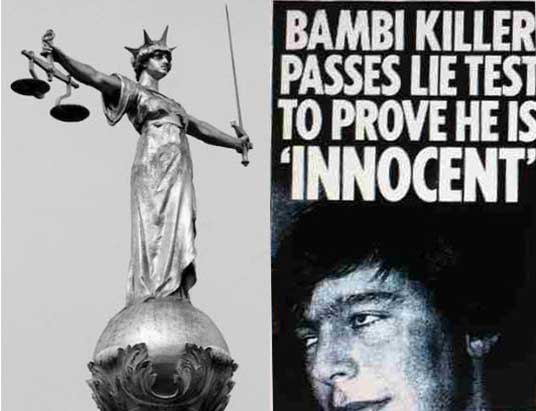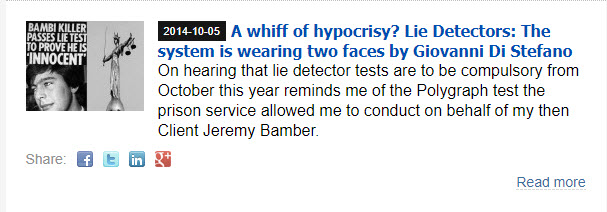

PSM/SLI/SMM/BAMBER
3 August 2005
Secretary of State for the
Home Department,
2 Marsham Street,
London, SW1P 4DF
And By Fax : 020 7035 4745
Dear Sirs,
Re: Jeremy BAMBER
Application for Prerogative of Pardon
We act for Mr. Jeremy Bamber whom, as you will be personally aware, was convicted on the 28th October 1986 of five counts of murder by a majority verdict of 10 to 2 following a 19 day trial in the Crown Court at Chelmsford before Mr. Justice Drake and a jury.
He was sentenced to life imprisonment with a recommendation that he serve a minimum of 25 years.
Pursuant to his trial he sought Leave to Appeal against his Conviction but his Application was refused on the papers by the Single Judge and on the 20th March 1989 the Full Court, presided over by the then Lord Chief Justice Lane, heard his renewed Application for Leave.
The Court dismissed the said Application.
Under Section 9 of the Criminal Appeal Act 1995 the Criminal Cases Review Commission referred the matter back to the Court of Appeal and on the 12th December 2002 Lord Justice Kay delivered a 100 page Judgement dismissing the said appeal.
It is of course true to say that the matter is currently again with the Criminal Cases Review Commission on new evidence based upon the abysmal failure on behalf of the Crown Prosecution Service and, more importantly, the Essex Police in disclosure.
It is correct to say that perhaps slightly less than one quarter of the 4 million or so documents still have not been disclosed to the Defence, although in the 38 boxes of papers that we received, it is also true to say there were a number of documents and, more importantly, photographs contained within which did not form part of the Defence papers either at (a) trial (b) the 1989 appeal and (c) the 2002 appeal.
Applications have been made to the Criminal Cases Review Commission and, as we have stated, it is absolutely correct to state that those investigations are ongoing. However, certain information has recently come to light which concerns a photograph which was discovered by ourselves amongst the papers, namely a post mortem photograph of Sheila Caffell’s wounds and the blood flow from her neck taking into consideration that the said blood flow was fresh and certainly, as per the photograph, could be deemed to be extremely recent.
That is a subject matter which is attracting the attention of the Criminal Cases Review Commission.
On the 28th July 2005 amongst the papers was discovered a Witness Statement from PC Peter Woodcock ATS 426 which, although dated 20th September 1985, refers to his visit to the scene of the crime at 7.34 am in the morning. In short this Witness Statement which, whilst we cannot be 100% certain did not form part of the trial bundle, certainly must be deemed corroborative of the photograph that we discovered which definitely did not form part of the trial bundle.
PC Woodcock states the following :
“She had what appeared to be two bullet holes under her chin and blood leaking from both sides of her mouth down her cheeks”.
This Statement clearly is corroborative to the photographs of Sheila Caffell with blood leaking down from her neck which we submitted to the Commission and which, at the cost of being again repetitive, there was a clear and distinct failure on the part of the Crown to disclose to the Defence.
The Statement of PC Woodcock who was the first officer to enter the house at 7.34 am states that there was “blood leaking from both sides of her mouth down her cheeks”. We know from his Witness Statement this was at 7.34 am. We also know from common medical knowledge that blood flowing the way that (a) the photograph proves and (b) evidence by the Statement of PC Woodcock, namely of leaking and or flowing, clearly confirms that at a very maximum, the time of death must have been 1 ½ hours from the time of either (a) the discovery of the body which was within 10 minutes of 7.34 am or (b) the photograph which we know was taken between 8.30 and 9.20 am on the said day of the tragedy.
That being the case and that evidence now being available, quite frankly, make it impossible for our client to have been responsible for the said murders.
Quite apart from this, there are the radio and telephone logs, again that were not disclosed to the Defence and to which the Chief Prosecutor, Mr. Anthony Arlidge QC has written to us confirming that he has never had sight of the said logs, which show (a) that at approximately 5.24 am there was conversation and movement by the police with someone inside the house, and (b) that upon entry to the house there was a “dead male and dead female body in the kitchen”.
The Prosecution allege that Sheila Caffell was found upstairs but the documents by the police, which they failed to disclose not only to the Defence but also to their own Prosecutor, tell a very different story.
The questions to be asked are that if indeed Sheila Caffell was found downstairs, how she then found herself upstairs by the time that PC Woodcock allegedly states that he found her.
Quite apart from the deplorable state of affairs and the fact that our client has now been 20 years in prison for a crime that it is evidently clear now by (a) the photographic evidence that the Crown failed to disclose, and (b) the corroboration of the blood flow by PC Woodcock in a Statement dated almost a year after the event and which, as we have stated, whilst we cannot be 100% certain was not disclosed, certainly the amount of documentation still covertly maintained by the Crown, over 600,000 pieces of paper, goes to the heart of the merits of our request.
It is of course true to say, as we have already perhaps overstated, that there is an Application to the Criminal Cases Review Commission and that, ultimately, this matter may find itself back to the Court of Appeal. Nevertheless, our client continues to be in custody and, as you will also be aware, last year was savagely attacked with a knife by an inmate for reasons that have never really been ascertained and which the Authorities almost invariably were aware that the assailant was a man of extreme danger.
In short, our client continues his detention, notwithstanding all of the above factors because perhaps there is really no system upon which any Authority, even the Crown Prosecution Service, the Police or the Court, can effect a release without the implementation of the 1995 Criminal Appeal Act and the Criminal Cases Review Commission making a referral.
In all the circumstances, we take the view that the appropriate course is for the Secretary of State for the Home Department in the exercise of his Prerogative Powers to grant a Pardon.
The exercise of this Prerogative Power to Pardon does not necessarily have to be a free pardon but can be conditional or in the form of a remission or a partial remission of sentence :
R –v- Secretary of State for the Home Department. Ex p. Bentley [1994] QB 349. Moreover, the Crown may exercise the prerogative right of granting a reprieve, which can be effected by announcing its pleasure in any way: 2 Hale PC 412. Since at least 1830 constitutionally the Crown has acted in the matter of reprieve on the uncontrolled responsibility of the Home Secretary: see Mackintosh “The British Cabinet” (2nd Ed) page 328 note 4; Sir Edward Troup “The Home Office” (Whitehall series) Chapter V. (referred to in Halsbury’s Laws of England 4th Ed Volume 8(2) paragraph 825, footnote1).
We are of course aware that this is perhaps one of the most high profile cases in recent British criminal history and that, according to papers we have seen, the Director of Public Prosecutions and Attorney General and the then Secretary of State for the Home Department certainly played a role. There are no allegations of misfeasance in public office save that there is clearly reference to the fact that the Secretary of State was made aware of the events from the beginning and was copied on correspondence between the then Prosecution, which was initiated in those days by the police, although there is no evidence that after 2002 the Secretary of State played any part in this whatsoever, other than of course the role of fixing the tariff.
In light of this evidence and in light of the way upon which matters have progressed and clearly the unsatisfactory situation on disclosure and the evidence found by ourselves and submitted to the Criminal Cases Review Commission now clearly suggest that Jeremy Bamber is not only technically and as a matter of law not guilty of these offences (the sheer size of the 600,000 or more pages of documents which the Crown failed to disclose is in itself per se a point of appeal) but that the simple photograph at the scene of the crime taken of Sheila Caffell with blood pouring from her neck and now the corroboration from the police officer Woodcock confirming that “blood was leaking from both sides of her mouth down her cheeks” show that since Mr. Bamber was with the police from 3 am and the cause of death having been ascertained as two bullet wounds and the oozing, leaking, flowing of blood taken in evidence make it impossible for Jeremy Bamber to be factually guilty of murder.
The use of the prerogative pardon, it is conceded, must be one that is administered with care and consideration. There is a real anger and a real fear that if a serious miscarriage of justice continues to be done and the public confidence in the criminal justice system must be one that when the Crown or the Executive understand and realise that a potential miscarriage of justice is apparent and not remedied, then the implications for the Crown and the Executive can be reflected upon the public confidence in the criminal justice system.
It is for these reasons that the Secretary of State is required to adopt the prerogative of pardon with the proviso and the understanding that it is in the form of remission of sentence. The quest for Mr. Bamber continues with the Criminal Cases Review Commission and can indeed continue until such time as the courts make an ultimate decision.
In the case of Susan May, the Parole Board duly released Miss May on parole notwithstanding her continued protestations of innocence and continued application currently with the Criminal Cases Review Commission.
Under normal circumstances, we would ask, and we do so in the alternative, for the Secretary of State to refer the matter to the Parole Board in a similar manner to that of Susan May with a view to releasing Mr. Bamber on licence if the Secretary of State feels that the time has not yet arrived when the prerogative of pardon cam be adopted. That being so, our prime objective is to (a) place information before the Secretary of State and (b) a formal application for the Secretary of State to use the prerogative of pardon and release Mr. Bamber forthwith.
This will in no way, as we have stated, interfere with the current ongoing Application to the Criminal Cases Review Commission and, in our view and taking into consideration that within the 4 million or so documents, notwithstanding that over 600,000 documents have failed to be disclosed, but one critical key factor was never dealt with either during the time of the investigation, the trial, the two appeals and to date.
Professor Vanezis who was the pathologist never stated in his Report his opinion on the time of death. We would have thought this would have been crucial and critical but it is evidently clear that the pathologies at the scene of the crime having witnessed and seen and in fact ordering photographs to be taken, having seen blood flowing from the neck of Sheila Caffell and then invariably reviewing the Witness Statements of the police (save of course for the Witness Statement dated 20th September 1985 of PC Woodcock had not been disclosed to the pathologist and of course the close up photograph of Sheila Caffell not having been disclosed to the pathologist), he could never have failed to give even a basic estimate of time of death.
It is clear when one reviews the scene of crime photographs that, for example, on June Bamber there is undoubtedly dried blood by the time the photographs were taken. However Sheila Caffell was a different story which was in itself, without even precise medical qualification, shows to the untrained eye that the time of death was fairly recent, otherwise the blood would not be flowing or leaking.
Under those circumstances, it would be wholly wrong and inequitable for Jeremy Bamber to remain a single day longer in custody when there is this specific doubt. The only mechanism which allows our client’s release is either the grant of parole licence by the Parole Board (which can take up to nine months) or the prerogative of pardon by the Secretary of State.
Whilst of course, to coin a phrase, beggars cannot be choosers, and this is not a situation where such should be the case, we will of course accept an urgent and immediate referral to the Parole Board by the Secretary of State but the preferable and more obvious avenue is clearly that, in this case, the Secretary of State must apply the prerogative of pardon.
This we kindly request to be done on an urgent basis.
We take this opportunity of thanking you for your kind consideration.
Yours faithfully,


